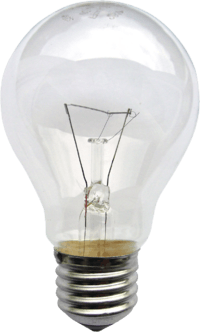List of light sources

This is a list of sources of light, including both natural and artificial processes that emit light. This article focuses on sources that produce wavelengths from about 390 to 700 nanometers called visible light.
Electric discharge
-
- Electrodeless lamp
- Excimer lamp
- Fluorescent lamp
- Compact fluorescent lamp
- Tanning lamp
- Black lights
- Geissler tube
- Moore tube (Defunct)
- "Ruhmkorff" lamp (Defunct)
- High-intensity discharge lamp
- Hollow-cathode lamp
- Induction lighting
- Sulfur lamp Sulfur lamps
- Sulfur lamp
- Neon and argon lamps
- Dekatron (Defunct)
 Dekatron
Dekatron - Nixie tube
- Dekatron (Defunct)
- Plasma lamp
- Xenon flash lamp
Incandescence
Incandescence is the emission of light from a hot body as a result of its temperature.
- Black-body radiation
- Carbon button lamp (Defunct)
- Earthquake light
- Halogen lamp
- Incandescent light bulb
 Incandescent light bulb
Incandescent light bulb - Lava
- Nernst lamp (Defunct)
- Volcanic eruption
 Volcanic eruption
Volcanic eruption
Combustion
Lamps
- Argand lamp (Defunct)
- Argon flash
- Carbide lamp (Defunct)
- Betty lamp (Defunct)
- Butter lamp
- Flash-lamp (Defunct)
- Gas lighting
- Gas mantle
- Kerosene lamps
- Lanterns
- Limelights (Defunct)
- Oil lamps Oil lamp
- Tilley lamp (Defunct)
Other
- Bunsen burner
- Candle
.jpg) Candle
Candle - Embers
- Explosives
- Fire
 Fire
Fire - Fire whirl
 Fire whirl
Fire whirl - Fireworks
 Fireworks
Fireworks - Flamethrower
- Muzzle flash
- Rubens' tube
- Torch
Nuclear and high-energy particle
- Annihilation
- Bremsstrahlung
- Čerenkov radiation
 Čerenkov radiation
Čerenkov radiation - Cyclotron radiation
- Fusor Fusor
- Nuclear explosion
- Scintillation
- Synchrotron light source
Celestial and atmospheric


Luminescence
Luminescence is emission of light by a substance not resulting from heat.
Chemiluminescence
Chemiluminescence is light resulting from a chemical reaction.
Bioluminescence
Bioluminescence is light resulting from biochemical reaction by a living organism.
- Aequorea victoria
- Antarctic krill
- Cavitation bubbles
- Foxfire
- Glowworm
- Luciferase
- Panellus stipticus
 Bioluminescent panellus stipticus
Bioluminescent panellus stipticus - Parchment worm
- Piddock
Electrochemiluminescence
Electrochemiluminescence is light resulting from electrochemical reaction.
Crystalloluminescence
Crystalloluminescence is light produced during crystallization.
Electroluminescence
Electroluminescence is light resulting of an electric current passed through a substance.
- Light-emitting diodes
- Organic light-emitting diodes
- Polymer light-emitting diodes
- AMOLED
- Light-emitting electrochemical cell
- Electroluminescent wires
- Field-induced polymer electroluminescent
- Laser
 Lasers
Lasers
Cathodoluminescence
Cathodoluminescence is light resulting from a luminescent material being struck by the electrons.
Mechanoluminescence
Mechanoluminescence is light resulting from a mechanical action on a solid.
Triboluminescence, a type of mechanoluminescence, is light generated when bonds in a material are broken when that material is scratched, crushed, or rubbed.
Fractoluminescence, a type of mechanoluminescence, is light generated when bonds in certain crystals are broken by fractures.
Piezoluminescence, a type of mechanoluminescence, is light produced by the action of pressure on certain solids.
Sonoluminescence, a type of mechanoluminescence, is light resulting from imploding bubbles in a liquid when excited by sound.
Photoluminescence
Photoluminescence is light resulting from absorption of photons.
Fluorescence, a type of photoluminescence, is the emission of light by a substance that has absorbed light or other electromagnetic radiation.
Unlike fluorescence, a phosphorescent material does not immediately re-emit the radiation it absorbs.
Radioluminescence

Radioluminescence is light resulting from bombardment by ionizing radiation.
Thermoluminescence
Thermoluminescence is light from the re-emission of absorbed energy when a substance is heated.
Cryoluminescence
Cryoluminescence is the emission of light when an object is cooled.
See also
External links
- A CD spectrometer Color spectrographs of common light sources
- The Double Amici Prism Hand-Held Spectroscope in Practice – Dozens of raw visible spectra of a wide variety of light sources.
